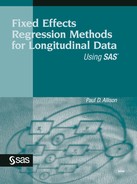2.8. Summary
Fixed effects linear models for quantitative response variables can be estimated in several different but equivalent ways:
If there are exactly two observations per individual, compute difference scores for all variables and then apply OLS regression to the difference scores.
Organize the data so that there is one record for each occasion for each individual. Do OLS with dummy variables for all individuals (less one).
For the data structure in method 2, express all variables as deviations from individual-level means. Then do OLS on the deviation scores, with corrections for standard errors, test statistics, and p-values. This is conveniently done in PROC GLM using the ABSORB statement.
For the data structure in method 2, express only the predictor variables as deviations from individual-level means. Then estimate a random effects model using PROC MIXED, with predictor variables including both the means and deviations from the means.
Of these methods, the fourth is the most flexible. It offers the following capabilities not shared with one or more of the other methods:
the inclusion of predictor variables that do not vary within individuals
a test of the fixed effects vs. random effects assumption
random coefficients for those predictors that vary within individuals
less restrictive error structures
Regardless of which computational method is used, the fixed effects method effectively controls for all individual-level covariates, both measured and unmeasured. This is its principal attraction as compared with random effects methods or GEE estimation. A key assumption of the fixed effects method, however, is that the individual-level covariates must have the same effects at all occasions. Variables whose effects are not constant across occasions must be explicitly included in the model.
